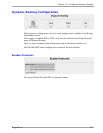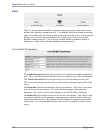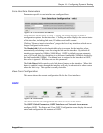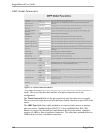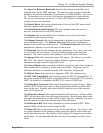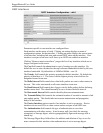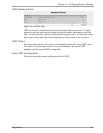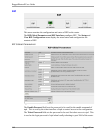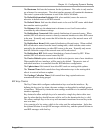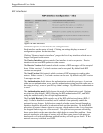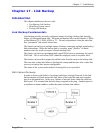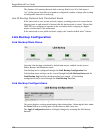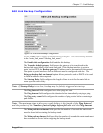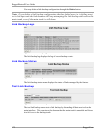
Chapter 16 - Configuring Dynamic Routing
The Hostname field sets the hostname for the rip daemon. This value is only used as
a a reference for convenience. The telnet interface prompt will contain this hostname.
The router's system wide hostname is used if this field is left blank.
The Default-Information Originate field, when enabled, causes the router to
advertise its default route to the RIP network.
The Default Metric field sets the default metric to be used for RIP routes which don't
have another metric specified.
The Distance field sets the administrative distance to use for all routes unless
overridden by other distance settings.
The Redistribute Connected fields control distribution of connected routes. When
enabled, RIP will advertise routes to directly connected interfaces to other RIP routers
in the area. Normally only routes that fall within the scope of the network areas will
be advertised.
The Redistribute Kernel fields control distribution of kernel routes. When enabled,
RIP will advertise routes from the kernel routing table, which includes static routes
entered by the administrator, to other RIP routers in the area. Normally only routes
that fall within the scope of the network areas will be advertised.
The Redistribute RIP fields control distribution of routes learned by RIP. When
enabled, RIP will advertise routes learned by RIP.
The Passive Default option controls the default active/passive state of new interfaces.
When enabled all new interfaces will be passive by default. The passive state of
individual interfaces is controlled from the RIP Interfaces configuration.
The Update timer field controls how often RIP sends out routing table updates.
The Timeout Timer field controls how long information stays in the routing table
after it is received without an update.
The Garbage Collection Timer field controls how long expired entries are
remembered before being purged.
RIP Key Chains
The Key Chains table configures authentication keys used on the interfaces. By
defining the keys in a key chain, the same settings can be applied to multiple groups
of interfaces. Without key chains the same settings would have to be entered for each
interface separately.
Key chains also allow multiple keys to be entered in a single key chain with a start
time for when that key should become valid as well as the duration the key is valid.
This allows multiple keys to be set up with automatic transitions from one key to the
next over time.
A key consists of a key string, which is the value used for authentication. It also has
the optional lifetime to accept RIP messages with the key, and the optional lifetime to
send RIP messages with that key.
RuggedCom 165



